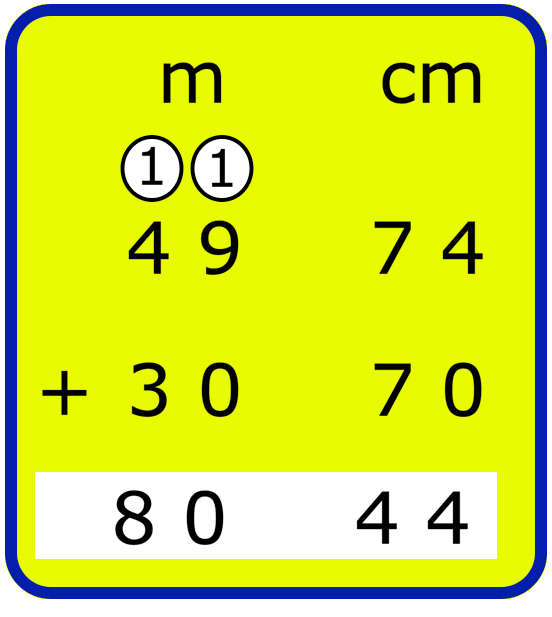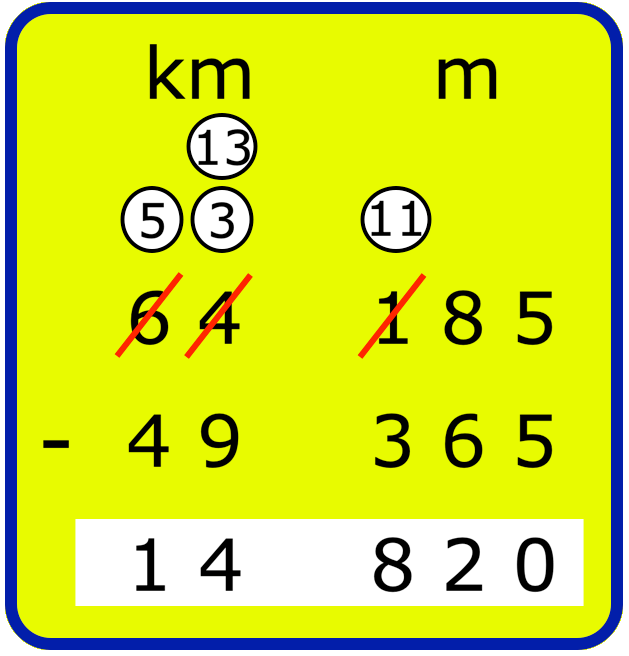Subscribe to our ▶️ YouTube channel 🔴 for the latest videos, updates, and tips.
Addition and Subtraction of Measuring Length
We will discuss about addition and subtraction of measuring length. We know the measure of length is required to know how tall a boy or a girl is or, how long the cloth is.
Meter is the standard unit of length. If we divide the length of a meter in 100 equal parts, each part is known as a centimeter. Centimeter is also a unit to measure small lengths.
Students use a scale to measure different lengths. Scale (ruler), measuring tape, cloth measuring rod, etc., are made to measure in meters and centimeters. Meters and centimeters are written as ‘m’ and ‘cm’ in brief as 5 m, 8 m, 2.5 cm, 7.5 cm etc.
Relationship between meter and centimeter:
We know one of the 100 parts of a meter is called a centimeter.
So, 1 meter = 100 centimeters
or, 1 m = 100 cm
and, 100 cm = 1 m
Addition and subtraction of measuring length in meter and centimeter:
Addition of Length
1. Add 49 m 74 cm and 30 m 70 cm.
Solution:
Step I: Write the lengths to be added in m and cm columns as shown.
Step II: Add the centimetres.
Step III: Add the metres. Do not forget to add the carry overs.
Therefore the answer is 80 m 44 cm.
Subtraction of Length
2. Subtract 49 km 365 m from 64 km 185 m
Solution:
Subtract 49 km 365 m from 64 km 185 m
= 64 km 185 m - 49 km 365 m
Step I: Write the lengths to be subtracted in km and m columns as shown.
Step II: Subtract the metres.
Step III: Then subtract the kilometres.
Therefore, the answer is 14 km 820 m
Addition and Subtraction of Length
3. A room is of 6 m length and 4 m breadth.
(i) Find the sum of its length and breadth.
(ii) Find the difference in length and breadth.
Solution:
(i) Sum = 6 m + 4 m = 10 m
or, 6 m
+ 4 m
10 m
Therefore, sum = 10 m
(ii) Difference = 6 m – 4 m = 2 m
or, 6 m
- 4 m
2 m
Therefore, difference = 2 m
Addition and Subtraction of Length
4. There are two line-segments. One is 8 cm long and other is 5 cm long.
(i) Find the total length of both the line-segments.
(ii) Find the difference between the lengths of the segments.
Solution:
(i) Total length = 8 cm + 5 cm = 13 cm
or, 8 cm
+ 5 cm
13 cm
Therefore, total length of both the line-segments = 13 cm
(ii) Difference = 8 cm - 5 cm = 3 cm
or, 8 cm
- 5 cm
3 cm
Therefore, difference between the lengths of the segments = 3 cm
From Addition and Subtraction of Measuring Length to HOME PAGE
Didn't find what you were looking for? Or want to know more information about Math Only Math. Use this Google Search to find what you need.




New! Comments
Have your say about what you just read! Leave me a comment in the box below. Ask a Question or Answer a Question.